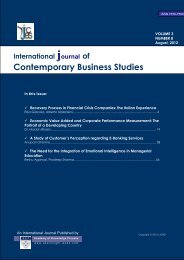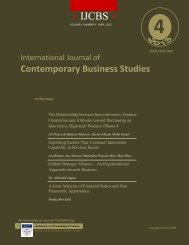Contemporary Business Studies - Academy of Knowledge Process ...
Contemporary Business Studies - Academy of Knowledge Process ...
Contemporary Business Studies - Academy of Knowledge Process ...
You also want an ePaper? Increase the reach of your titles
YUMPU automatically turns print PDFs into web optimized ePapers that Google loves.
International Journal <strong>of</strong> <strong>Contemporary</strong> <strong>Business</strong> <strong>Studies</strong>Vol: 4, No: 2. February, 2013 ISSN 2156-7506Available online at http://www.akpinsight.webs.comresearchers have also emphasized the spillover caused by the family demands onto the work lives <strong>of</strong> theemployees. This again is highly relevant in case <strong>of</strong> dual-career couples. For this group there is a time andenergy deficit where the employee not only strives to meet his/her own work & family demands but also<strong>of</strong> the partner. Even a crossover <strong>of</strong> emotions between the partners was observed and studied <strong>of</strong>f late(Brummelhuis, Haar & Lippe, 2010). Life satisfaction can create colossal catastrophic consequences forboth, the individual as an employee or the individual as a family member. The catastrophic consequencesfor organizations are generally in the form <strong>of</strong> job dissatisfaction, reduced job performance and affectivecommitment and high turnover. The catastrophic consequences for a family and its members are spilloverand crossover effects, time and energy deficits.2. RATIONALE AND SCOPE OF THE STUDYThere has been a growing concern about the role <strong>of</strong> modern day service organizations whose primaryfocus is on customer satisfaction and pr<strong>of</strong>it making. This is creating organizational situations in which thework and family roles are getting blurred with the growing responsibilities at work. Against thisbackground, the present study has been conducted to find out the various issues underlying Lifesatisfaction and to present them as a composite whole and in the process identify all the possible futuredirections for research in this area. This paper studies the researches that have been conducted in the area<strong>of</strong> Life satisfaction during 1978 to 2011.3. OBJECTIVES OF THE STUDYThis study has been conducted with the prime objectives <strong>of</strong> organizing the publications on Lifesatisfaction in an orderly manner so as to enable easy and quick access, classifying literature on Lifesatisfaction and analyzing the outcome <strong>of</strong> the studies reviewed. The paper also seeks to identify the gapsin the existing literature and suggests the future directions for research in Life satisfaction.4. METHODOLOGYThe paper is based upon studies conducted on Life satisfaction in various countries. A total <strong>of</strong> 50 papers(all from refereed journals) have been reviewed. The distribution <strong>of</strong> articles reviewed from varioussources is given in Table 4. All these papers are classified on the basis <strong>of</strong> various approaches & issuescovered and presented in the Literature review. Life satisfaction literature (for the 50 papers reviewed)majorly deals with Job Satisfaction, Work/Family Demands, Education effects, Gender effects and Timeeffects (Figure 1). Methodological classification <strong>of</strong> the studies has also been represented in Table 2 &Figure 2. Additionally, cataloging <strong>of</strong> the studies has been done in Table 3 & Figure 3 for year-wise dataand Table 5 & Figure 4 for country-wise data.5. LITERATURE ON LIFE SATISFACTION5.1 Relationship between Life Satisfaction & Job SatisfactionNear, Rice & Hunt (1978) in their research on what actually comprised <strong>of</strong> the life satisfaction found thatLife Satisfaction was a multi-component concept with Job Satisfaction, Satisfaction with Home & Healthbeing a part <strong>of</strong> the overall Life Satisfaction. Later studies conducted by (Chacko I. Thomas, 1983)examined the functional relationship between job satisfaction and general life satisfaction. In a generalsense the results are more supportive <strong>of</strong> the notion that job satisfaction has a greater influence on life ornon-work satisfaction (spillover model) unlike the compensatory model that suggests contrasts or anegative relation or effect between job and life satisfactions. (Schmitt & Pulakos,1985) in their paperexamined the inter-relationships between job & life satisfaction and indicated that, after controlling fordemographic variables, life satisfaction predicted job satisfaction but in the case <strong>of</strong> retirees, jobsatisfaction predicted life satisfaction. Another study by (Booth & Ours, 2007) investigated therelationship between part-timework and working hours satisfaction; job satisfaction; and life satisfaction.It was found that men have the highest hours-<strong>of</strong>-work satisfaction if they work full-time without overtimehours but neither their job satisfaction nor their life satisfaction are affected by how many hours they2013©<strong>Academy</strong> <strong>of</strong> <strong>Knowledge</strong> <strong>Process</strong>33
















